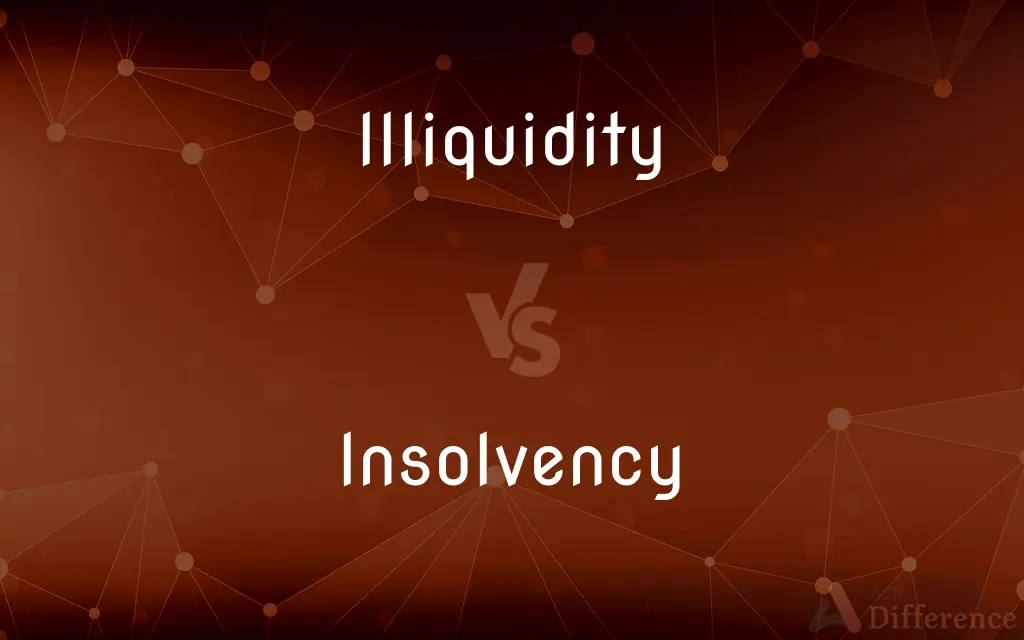Illiquidity vs. Insolvency — What's the Difference?
By Fiza Rafique & Maham Liaqat — Updated on April 4, 2024
Illiquidity refers to the difficulty of converting assets to cash without significant loss, focusing on short-term cash flow. Insolvency is a state where liabilities exceed assets, indicating an inability to meet long-term financial obligations.

Difference Between Illiquidity and Insolvency
Table of Contents
ADVERTISEMENT
Key Differences
Illiquidity is a financial situation characterized by an entity's difficulty in quickly converting assets into cash without incurring substantial losses. This condition primarily concerns the short-term ability to meet cash needs and obligations. On the other hand, insolvency represents a more severe financial state where an entity's total liabilities surpass its total assets, indicating an inability to fulfill long-term financial commitments and debts.
Entities facing illiquidity may still be solvent, possessing sufficient assets to cover all debts; however, they struggle with accessing cash or liquid assets in a timely manner to settle short-term liabilities. Whereas, insolvent entities face a more dire situation where, even if all assets were liquidated, there would not be enough funds to pay off all debts, pointing to fundamental issues in the entity's financial structure and health.
The primary concern of illiquidity is the management of cash flow and the ability to turn assets into cash to meet immediate and short-term obligations without significant loss. Conversely, insolvency is concerned with the overall financial stability and viability of an entity, questioning whether the entity's business model and operations are sustainable in the long run.
Solutions to illiquidity often involve improving cash management, securing short-term financing, or converting assets to more liquid forms. These strategies aim to bridge temporary gaps between cash inflows and outflows. On the other hand, addressing insolvency may require more drastic measures, such as restructuring debts, selling off substantial assets, or undergoing legal bankruptcy proceedings to resolve the mismatch between liabilities and assets.
While illiquidity can be a temporary issue, resolved with proper financial management and strategic planning, insolvency indicates a fundamental failure in an entity's ability to generate enough value to cover its obligations, often leading to more complex legal and financial interventions to protect the interests of creditors and stakeholders.
ADVERTISEMENT
Comparison Chart
Definition
Difficulty in converting assets to cash without significant loss.
A state where liabilities exceed assets, indicating inability to pay debts.
Focus
Short-term cash flow and asset liquidity.
Overall financial health and long-term obligations.
Implications
May struggle to meet immediate financial obligations.
Unable to meet long-term financial obligations, regardless of asset liquidation.
Solutions
Cash management improvement, short-term financing, asset liquidation.
Debt restructuring, asset sell-off, bankruptcy proceedings.
Potential Outcome
Can be temporary if managed correctly.
Indicates a fundamental financial failure, may lead to bankruptcy.
Compare with Definitions
Illiquidity
Difficulty in quickly converting assets to cash.
The company faced illiquidity, unable to promptly sell its real estate to pay short-term debts.
Insolvency
A legal financial status implying potential bankruptcy.
The court declared the corporation insolvent after reviewing its balance sheet.
Illiquidity
A situation requiring strategic financial management to avoid default.
The CFO implemented strict cash flow management to navigate the firm's illiquidity.
Insolvency
The inability to pay debts when they are due.
Insolvency led to creditors filing for the company's bankruptcy.
Illiquidity
A financial state where assets cannot be easily sold.
Despite its valuable inventory, the retailer experienced illiquidity during the cash crunch.
Insolvency
A state where liabilities exceed assets.
Declining sales and rising debts pushed the company into insolvency.
Illiquidity
A condition of having insufficient cash to meet immediate obligations.
The sudden withdrawal of a credit line led to illiquidity for the small business.
Insolvency
A fundamental failure in financial viability.
Insolvency forced the historic theater to permanently close its doors.
Illiquidity
The risk of loss when selling assets to obtain cash.
Illiquidity in the art market meant selling pieces at a significant discount.
Insolvency
A condition requiring significant financial restructuring.
To address insolvency, the company negotiated debt forgiveness with lenders.
Illiquidity
Not readily converted into cash
Illiquid assets.
Insolvency
In accounting, insolvency is the state of being unable to pay the debts, by a person or company (debtor), at maturity; those in a state of insolvency are said to be insolvent. There are two forms: cash-flow insolvency and balance-sheet insolvency.
Illiquidity
Lacking cash or liquid assets.
Insolvency
The condition of being insolvent.
Illiquidity
(economics) The condition of being illiquid; a lack of liquidity; difficulty in selling out an asset
Insolvency
An instance of being insolvent.
Insolvency
(finance) The condition of being insolvent; the state or condition of a person who is insolvent; the condition of one who is unable to pay his debts as they fall due, or in the usual course of trade and business.
The company faces insolvency.
Insolvency
Insufficiency to discharge all debts of the owner.
The insolvency of an estate
Insolvency
The condition of having more debts than assets.
Insolvency
The condition of being insolvent; the state or condition of a person who is insolvent; the condition of one who is unable to pay his debts as they fall due, or in the usual course of trade and business; as, a merchant's insolvency.
Insolvency
The lack of financial resources
Common Curiosities
How can illiquidity be resolved?
Illiquidity can be resolved by improving cash management, obtaining short-term financing, or liquidating assets to increase cash flow.
Is insolvency always the result of poor financial management?
While poor financial management can lead to insolvency, it can also result from external factors like market downturns, sudden loss of revenue, or unexpected large expenses.
Can insolvency be a strategic decision?
While insolvency itself is not a strategy, some companies may strategically file for bankruptcy to reorganize and eliminate unmanageable debts under legal protection.
Can an individual be insolvent?
Yes, individuals can also be insolvent, facing a situation where their total debts exceed their assets, and they are unable to meet their financial obligations.
Can restructuring debt solve insolvency?
Debt restructuring can be a solution to insolvency if it successfully lowers the debt burden, making the liabilities more manageable within the entity's financial capabilities.
Is illiquidity a sign of financial instability?
Illiquidity can indicate financial instability if it persists, showing that the entity struggles to manage its cash flow effectively.
Are there early warning signs of insolvency?
Early warning signs include consistent cash flow problems, rising debt levels, and deteriorating financial ratios.
How do shareholders get affected by insolvency?
Shareholders may lose their investment if a company becomes insolvent and goes through bankruptcy, as they are last in line to get paid.
Can a company be insolvent but not illiquid?
Yes, a company can have enough liquid assets to cover short-term obligations (not illiquid) but still be insolvent if its total liabilities exceed its assets.
What happens if insolvency is not addressed?
If insolvency is not addressed, it can lead to bankruptcy, where legal proceedings may liquidate the company's assets to pay creditors.
Can government intervention prevent a company's insolvency?
In some cases, government intervention, such as bailouts or financial assistance, can prevent a company's insolvency.
What is the difference between bankruptcy and insolvency?
Insolvency is a financial condition of being unable to pay debts, whereas bankruptcy is a legal process aimed at resolving insolvency under the protection of the law.
How do creditors respond to illiquidity and insolvency?
Creditors may offer temporary relief for illiquidity but may seek legal remedies, including filing for the debtor's bankruptcy, in cases of insolvency.
Can insolvency affect a company's credit rating?
Yes, insolvency can significantly affect a company's credit rating, making it difficult to secure financing in the future.
Does illiquidity affect all types of assets equally?
No, illiquidity affects assets differently; typically, assets like stocks are more liquid than assets like real estate or specialized equipment.
Share Your Discovery

Previous Comparison
Booking vs. Backlog
Next Comparison
Evergreen vs. PersonAuthor Spotlight
Written by
Fiza RafiqueFiza Rafique is a skilled content writer at AskDifference.com, where she meticulously refines and enhances written pieces. Drawing from her vast editorial expertise, Fiza ensures clarity, accuracy, and precision in every article. Passionate about language, she continually seeks to elevate the quality of content for readers worldwide.
Co-written by
Maham Liaqat














































